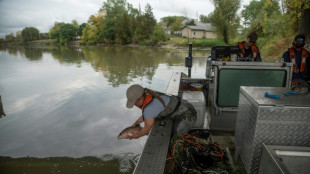
-
 Daryz wins Prix de l'Arc de Triomphe thriller
Daryz wins Prix de l'Arc de Triomphe thriller
-
Russell wins Singapore GP as McLaren seal constructors' title

-
 Landslides and floods kill 64 in Nepal, India
Landslides and floods kill 64 in Nepal, India
-
Russell wins Singapore GP, McLaren seal constructors' title

-
 Djokovic 'hangs by rope' before battling into Shanghai last 16
Djokovic 'hangs by rope' before battling into Shanghai last 16
-
Erasmus proud of Boks' title triumph as Rugby Championship faces uncertain future

-
 French PM under pressure to put together cabinet
French PM under pressure to put together cabinet
-
US Open finalist Anisimova beats Noskova to win Beijing title

-
 Hamas calls for swift hostage-prisoner swap as talks set to begin
Hamas calls for swift hostage-prisoner swap as talks set to begin
-
Opec+ plus to raise oil production by 137,000 barrels a day in November

-
 Death toll from Indonesia school collapse rises to 45
Death toll from Indonesia school collapse rises to 45
-
Brisbane Broncos edge Storm in thrilling NRL grand final

-
 Refreshed Sabalenka 'ready to go' after post-US Open break
Refreshed Sabalenka 'ready to go' after post-US Open break
-
Georgia PM vows sweeping crackdown after 'foiled coup'

-
 Landslides and floods kill 63 in Nepal, India
Landslides and floods kill 63 in Nepal, India
-
No handshakes again as India, Pakistan meet at Women's World Cup

-
 Georgia PM announces sweeping crackdown on opposition after 'foiled coup'
Georgia PM announces sweeping crackdown on opposition after 'foiled coup'
-
Syria selects members of first post-Assad parliament

-
 Russian strikes kill five in Ukraine, cause power outages
Russian strikes kill five in Ukraine, cause power outages
-
World champion Marquez crashes out of Indonesia MotoGP

-
 Babis to meet Czech president after party tops parliamentary vote
Babis to meet Czech president after party tops parliamentary vote
-
Death toll from Indonesia school collapse rises to 37

-
 OPEC+ meets with future oil production hanging in the balance
OPEC+ meets with future oil production hanging in the balance
-
Dodgers down Phillies on Hernandez homer in MLB playoff series opener

-
 Philadelphia down NYCFC to clinch MLS Supporters Shield
Philadelphia down NYCFC to clinch MLS Supporters Shield
-
Syria selects members of first post-Assad parliament in contested process

-
 Americans, Canadians unite in battling 'eating machine' carp
Americans, Canadians unite in battling 'eating machine' carp
-
Negotiators due in Cairo for Gaza ceasefire, hostage release talks

-
 Trump authorizes troops to Chicago as judge blocks Portland deployment
Trump authorizes troops to Chicago as judge blocks Portland deployment
-
Wallabies left ruing missed chances ahead of European tour

-
 Higgo stretches PGA Tour lead in Mississippi
Higgo stretches PGA Tour lead in Mississippi
-
Blue Jays pummel Yankees 10-1 in MLB playoff series opener

-
 Georgia ruling party wins local polls as mass protests flare
Georgia ruling party wins local polls as mass protests flare
-
Depoortere stakes France claim as Bordeaux-Begles stumble past Lyon

-
 Vinicius double helps Real Madrid beat Villarreal
Vinicius double helps Real Madrid beat Villarreal
-
New museum examines family life of Mexican artist Frida Kahlo

-
 Piccioli sets new Balenciaga beat, with support from Meghan Markle
Piccioli sets new Balenciaga beat, with support from Meghan Markle
-
Lammens must be ready for 'massive' Man Utd scrutiny, says Amorim

-
 Arteta 'not positive' after Odegaard sets unwanted injury record
Arteta 'not positive' after Odegaard sets unwanted injury record
-
Slot struggles to solve Liverpool problems after third successive loss

-
 Netanyahu hopes to bring Gaza hostages home within days as negotiators head to Cairo
Netanyahu hopes to bring Gaza hostages home within days as negotiators head to Cairo
-
Ex-NFL QB Sanchez in hospital after reported stabbing

-
 Liverpool lose again at Chelsea, Arsenal go top of Premier League
Liverpool lose again at Chelsea, Arsenal go top of Premier League
-
Liverpool suffer third successive loss as Estevao strikes late for Chelsea

-
 Diaz dazzles early and Kane strikes again as Bayern beat Frankfurt
Diaz dazzles early and Kane strikes again as Bayern beat Frankfurt
-
De Zerbi living his best life as Marseille go top of Ligue 1

-
 US envoys head to Mideast as Trump warns Hamas against peace deal delay
US envoys head to Mideast as Trump warns Hamas against peace deal delay
-
In-form Inter sweep past Cremonese to join Serie A leaders

-
 Kolisi hopes Rugby Championship success makes South Africa 'walk tall' again
Kolisi hopes Rugby Championship success makes South Africa 'walk tall' again
-
Ex-All Black Nonu rolls back the years again as Toulon cruise past Pau


Scientists find simple, safe method to destroy 'forever chemicals'
"Forever chemicals" used in daily items like nonstick pans have long been linked to serious health issues –- a result of their toxicity and extreme resistance to being broken down as waste products.
Chemists in the United States and China on Thursday said they had finally found a breakthrough method to degrade these polluting compounds, referred to as PFAS, using relatively low temperatures and common reagents.
Their results were published in the journal Science, potentially offering a solution to a longstanding source of harm to the environment, livestock and humans.
"It really is why I do science -- so that I can have a positive impact on the world," senior author William Dichtel of Northwestern University told reporters during a news conference.
PFAS, or per- and polyfluoroalkyl substances, were first developed in the 1940s and are now found in a variety of products, including nonstick pans, water-resistant textiles, and fire suppression foams.
Over time, the pollutants have accumulated in the environment, entering the air, soil, groundwater and lakes and rivers as a result of industrial processes and from leaching through landfills.
A study published last week by Stockholm University scientists found rainwater everywhere on the planet is unsafe to drink because of PFAS contamination.
Chronic exposure to even low levels has been linked to liver damage, high cholesterol, reduced immune responses, low birth weights, and several kinds of cancer.
Although PFAS chemicals can be filtered out of water, there are few good solutions for how to dispose of them once they have been removed.
- 10 down, thousands to go -
Current methods to destroy PFAS require harsh treatments, such as incineration at extremely high temperatures or irradiating them ultrasonic waves.
PFAS' indestructability comes from their carbon-flouride bonds, one of the strongest types of bonds in organic chemistry.
Fluorine is the most electronegative element and wants to gain electrons, while carbon is keen to share them.
PFAS molecules contain long chains of these bonds, but the research team was able to identify a glaring weakness common to a certain class of PFAS.
At one end of the molecule, there is a group of charged oxygen atoms which can be targeted using a common solvent and reagent at mild temperatures of 80-120 degrees Celsius, decapitating the head group and leaving behind a reactive tail.
"Once that happens, that provides access to previously unrecognized pathways that cause the entire molecule to fall apart in a cascade of complex reactions," said Dichtel, ultimately making benign end products.
A second part of the study involved using powerful computational methods to map out the quantum mechanics behind the chemical reactions the team performed to destroy the molecules.
The new knowledge could eventually guide further improvements to the method.
The current study focused on 10 PFAS chemicals including a major pollutant called GenX, which for example has contaminated the Cape Fear River in North Carolina.
But it represents just the tip of the iceberg, since the US Environmental Protection Agency has identified more than 12,000 PFAS chemicals.
"There are other classes that don't have the same Achilles’ heel, but each one will have its own weakness," said Dichtel in a statement.
"If we can identify it, then we know how to activate it to destroy it."
M.Furrer--BTB




